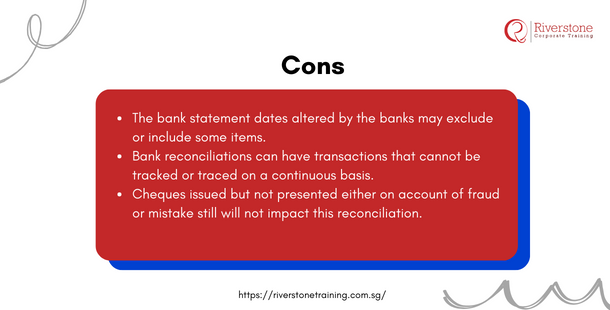
Bank Reconciliation Statement
Bank Reconciliation Statement:
Have you ever had issues with the cash and bank balance? Does it not correspond to the bank statement? You need a bank reconciliation statement. Bank reconciliation statement attempts to explain the difference in cash and bank balances in books of accounts and bank balances in a bank statement. A document reconciles the cash and bank balance in the balance sheet to the corresponding amount on the bank statement. The bank reconciliation statements are useful in identifying the difference in cash and bank balances, detecting frauds, and any cash adjustments. The bank reconciliation statements should be prepared regularly to ensure that cash accounts are free from mistakes and fraud.
Application of Bank Reconciliation Statement
- It is useful in correcting the disparities in the amount of cash and bank balance.
- The bank reconciliation will help identify issues such as,
- Cheque received but not deposited.
- Cheque deposited by not cleared.
- Cheque issued but not cleared.
- Cheque issued but not given.
- Bank charges not recorded in accounting records.
- Cheque bounced not recorded.
- Interest charged by the bank not recorded.
- Cheque directly deposited by clients not recorded in books.
- Cash deposited in a bank not recorded in books of accounts.
- Other transactions related to expenses, payment and receipt recorded in either bank statement or books of accounts.
- Bank reconciliation is essential for auditors. The auditors will always examine the company’s ending bank reconciliation while doing their audit.
Pros and cons
The bank reconciliation statement has merits and demerits. Let us consider the benefits and the demerits that are associated with the bank reconciliation statement.
Pros:
- Bank reconciliation makes the financial statement accurate.
- It’s a perfect way to take care of the fraudulent issues.
- Bank reconciliation take care of mistakes that might result from posting accounting information or error.
- It creates checks on the cash and bank balances and helps in monitoring of the same.
- It helps to track and contrail the receivables of the business.
Cons:
Despite the many benefits of bank reconciliation, there are some demerits!
- The bank statement dates altered by the banks may exclude or include some items.
- Bank reconciliations can have transactions that cannot be tracked or traced on a continuous basis.
- Cheques issued but not presented either on account of fraud or mistake still will not impact this reconciliation.
Conclusion
To conclude, a bank reconciliation statement is a useful tool that introduces transparency and efficiency in a business accounting system. It matches the book and the bank balances with bank statement and act as check and balances in the accounting system of the company.




